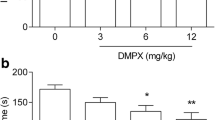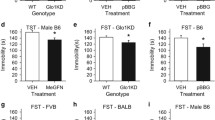Abstract
Rationale
We investigated the immediate and enduring effects of ketamine in behavioral and neurochemical assays predictive of antidepressant activity.
Materials and methods
One week after a single administration of ketamine (50–160 mg/kg), otherwise experimentally naive rats and mice were tested either in the forced swim test (FST) or the tail suspension test (TST). Other mice were also tested twice in the FST: immediately and 2 weeks after a single dose (1.25–50 mg/kg) of ketamine. In the next series of experiments, rats treated for 2 weeks twice daily with ketamine (50 or 160 mg/kg) or desipramine (10 mg/kg) were challenged with apomorphine and scored for locomotor activity and assayed for the density of cortical beta-adrenoceptors. The latter test was also carried out in rats that had received a single dose of ketamine (50 mg/kg) 1 week before the assay. The antidepressant-like (FST) and locomotor effects of ketamine (50 mg/kg) and desipramine (10 mg/kg) were assessed after their chronic (2 weeks, twice daily) administration as well.
Results
We report the lack of enduring antidepressant-like effect of ketamine in both rats and mice. A 2-week treatment with ketamine neither changed apomorphine-evoked locomotor hyperactivity nor did it decrease the density of cortical beta-adrenoceptors. However, some tolerance to the antidepressant-like effect of ketamine was noted in the FST, but it was accompanied by sensitization to its locomotor stimulatory effects.
Conclusions
These data indicate that ketamine neither produces enduring antidepressant-like effects in rodents nor does it display antidepressant-like behavioral or neurochemical effects after chronic treatment.





Similar content being viewed by others
References
Ainsworth K, Smith SE, Sharp T (1998) Repeated administration of fluoxetine, desipramine and tranylcypromine increases dopamine D2-like but not D1-like receptor function in the rat. J Psychopharmacol 12:252–257
Belozertseva I, Kos T, Popik P, Danysz W, Bespalov AY (2007) Antidepressant-like effects of mGluR1 and mGluR5 antagonists in the rat forced swim and the mouse tail suspension tests. Eur Neuropsychopharmacol 17:172–179
Berman RM, Cappiello A, Anand A, Oren DA, Heninger GR, Charney DS, Krystal JH (2000) Antidepressant effects of ketamine in depressed patients. Biol Psychiat 47:351–354
Borsini F, Meli A (1988) Is the forced swimming test a suitable model for revealing antidepressant activity? Psychopharmacology 94:147–160
Breier A, Adler CM, Weisenfeld N, Su TP, Elman I, Picken L, Malhotra AK, Pickar D (1998) Effects of NMDA antagonism on striatal dopamine release in healthy subjects: application of a novel PET approach. Synapse 29:142–147
Chaturvedi HK, Chandra D, Bapna JS (1999) Effect of NMDA antagonists in forced swimming test and its modification by antidepressants. Indian J Pharmacol 31:104–109
Check E (2006) Depression: comfortably numb. Nature 443:629–631
Correll GE, Futter GE (2006) Two case studies of patients with major depressive disorder given low-dose (subanesthetic) ketamine infusions. Pain Med 7:92–95
Corrigan MH, Denahan AQ, Wright CE, Ragual RJ, Evans DL (2000) Comparison of pramipexole, fluoxetine, and placebo in patients with major depression. Depress Anxiety 11:58–65
Cryan JF, Page ME, Lucki I (2005a) Differential behavioral effects of the antidepressants reboxetine, fluoxetine, and moclobemide in a modified forced swim test following chronic treatment. Psychopharmacology (Berl) 182:335–344
Cryan JF, Valentino RJ, Lucki I (2005b) Assessing substrates underlying the behavioral effects of antidepressants using the modified rat forced swimming test. Neurosci Biobehav Rev 29:547–569
Detke MJ, Rickels M, Lucki I (1995) Active behaviors in the rat forced swimming test differentially produced by serotonergic and noradrenergic antidepressants. Psychopharmacology (Berl) 121:66–72
Detke MJ, Johnson J, Lucki I (1997) Acute and chronic antidepressant drug treatment in the rat forced swimming test model of depression. Exp Clin Psychopharmacol 5:107–112
Frazer A (1997) Pharmacology of antidepressants. J Clin Psychopharmacol 17(Suppl 1):2S–18S
Garcia LS, Comim CM, Valvassori SS, Reus GZ, Barbosa LM, Andreazza AC, Stertz L, Fries GR, Gavioli EC, Kapczinski F, Quevedo J (2008) Acute administration of ketamine induces antidepressant-like effects in the forced swimming test and increases BDNF levels in the rat hippocampus. Prog Neuropsychopharmacol Biol Psychiatry 32:140–144
Goforth HW, Holsinger T (2007) Rapid relief of severe major depressive disorder by use of preoperative ketamine and electroconvulsive therapy. JECT 23:23–25
Griffiths RR, Richards WA, McCann U, Jesse R (2006) Psilocybin can occasion mystical-type experiences having substantial and sustained personal meaning and spiritual significance. Psychopharmacology (Berl) 187:268–283
Hayase T, Yamamoto Y, Yamamoto K (2006) Behavioral effects of ketamine and toxic interactions with psychostimulants. BMC Neurosci 7:1–10
Kapur S, Seeman P (2002) NMDA receptor antagonists ketamine and PCP have direct effects on the dopamine D(2) and serotonin 5-HT(2)receptors-implications for models of schizophrenia. Mol Psychiatry 7:837–844
Kos T, Legutko B, Danysz W, Samoriski G, Popik P (2006a) Enhancement of antidepressant-like effects but not BDNF mRNA expression by the novel NMDA receptor antagonist neramexane in mice. J Pharmacol Exp Ther 318:1128–1136
Kos T, Popik P, Pietraszek M, Schafer D, Danysz W, Dravolina O, Blokhina EA, Galankin T, Bespalov AY (2006b) Effect of 5-HT3 receptor antagonist MDL 72222 on behaviors induced by ketamine in rats and mice. Eur Neuropsychopharmacol 16:297–310
Krystal JH, Karper LP, Seibyl JP, Freeman GK, Delaney R, Bremner JD, Heninger GR, Bowers MB, Charney DS (1994) Subanesthetic effects of the noncompetitive NMDA antagonist, ketamine, in humans. Psychotomimetic, perceptual, cognitive, and neuroendocrine responses. Arch Gen Psychiatry 51:199–214
Lannes B, Micheletti G, Warter JM, Kempf E, Di Scala G (1991) Behavioural, pharmacological and biochemical effects of acute and chronic administration of ketamine in the rat. Neurosci Lett 128:177–181
Layer RT, Popik P, Olds T, Skolnick P (1995) Antidepressant-like actions of the polyamine site NMDA antagonist, eliprodil (SL-82.0715). Pharmacol Biochem Behav 52:621–627
Liebrenz M, Stohler R, Borgeat A (2007) Repeated intravenous ketamine therapy in a patient with treatment-resistant major depression. World J Biol Psychiatry i:1–4
Maeng S, Zarate CA Jr., Du J, Schloesser RJ, McCammon J, Chen G, Manji HK (2008) Cellular mechanisms underlying the antidepressant effects of ketamine: role of alpha-amino-3-hydroxy-5-methylisoxazole-4-propionic acid receptors. Biol Psychiatry 63:349–352
Mantovani M, Pertile R, Calixto JB, Santos AR, Rodrigues AL (2003) Melatonin exerts an antidepressant-like effect in the tail suspension test in mice: evidence for involvement of N-methyl-d-aspartate receptors and the l-arginine-nitric oxide pathway. Neurosci Lett 343:1–4
Martin D, Lodge D (1985) Ketamine acts as a non-competitive N-methyl-d-aspartate antagonist on frog spinal cord in vitro. Neuropharmacology 24:999–1003
Muscat R, Papp M, Willner P (1992) Antidepressant-like effects of dopamine agonists in animal model of depression. Biol Psychiatry 31:937–946
Ostroff R, Gonzales M, Sanacora G (2005) Antidepressant effect of ketamine during ECT. Am J Psychiatry 162:1385–1386
Papp M, Moryl E (1993) Similar effect of chronic treatment with imipramine and the NMDA antagonists CGP 37849 and MK-801 in a chronic mild stress model of depression in rats. Eur Neuropsychopharmacol 3:348–349
Paul IA, Trullas R, Skolnick P, Nowak G (1992) Down-regulation of cortical beta-adrenoceptors by chronic treatment with functional NMDA antagonists. Psychopharmacology 106:285–287
Popik P, Kostakis E, Krawczyk M, Nowak G, Szewczyk B, Krieter P, Chen Z, Russek SJ, Gibbs TT, Farb DH, Skolnick P, Lippa AS, Basile A (2006a) The anxioselective agent 7-(2-chloropyridin-4-yl)pyrazolo-[1,5-a]-pyrimidin-3-yl](pyridin-2-yl)methanone (DOV 51892) is more efficacious than diazepam at enhancing GABA-gated currents at alpha-1 subunit-containing GABAA receptors. J Pharmacol Exp Ther 319:1244–1252
Popik P, Krawczyk M, Golembiowska K, Nowak G, Janowsky A, Skolnick P, Lippa AS, Basile A (2006b) Pharmacological profile of the “triple” monoamine uptake inhibitor, DOV 102,677. Cell Mol Neurobiol 26:855–871
Porsolt RD, Le Pichon M, Jalfre M (1977) Depression: a new animal model sensitive to antidepressant treatments. Nature 266:730–732
Riedlinger TJ, Riedlinger JE (1994) Psychedelic and entactogenic drugs in the treatment of depression. J Psychoactive Drugs 26:41–55
Rosa AO, Lin J, Calixto JB, Santos AR, Rodrigues AL (2003) Involvement of NMDA receptors and l-arginine-nitric oxide pathway in the antidepressant-like effects of zinc in mice. Behav Brain Res 144:87–93
Sitland-Marken PA, Wells BG, Froemming JH, Chu CC, Brown CS (1990) Psychiatric applications of bromocriptine therapy. J Clin Psychiatry 51:68–82
Smith GS, Schloesser R, Brodie JD, Dewey SL, Logan J, Vitkun SA, Simkowitz P, Hurley A, Cooper T, Volkow ND, Cancro R (1998) Glutamate modulation of dopamine measured in vivo with positron emission tomography (PET) and 11C-raclopride in normal human subjects. Neuropsychopharmacology 18:18–25
Spyraki C, Fibiger HC (1981) Behavioural evidence for supersensitivity of postsynaptic dopamine receptors in the mesolimbic system after chronic administration of desipramine. Eur J Pharmacol 74:195–206
Steru L, Chermat R, Thierry B, Simon P (1985) The tail suspension test: a new method for screening antidepressants in mice. Psychopharmacology 85:367–370
Trujillo KA, Zamora JJ, Warmoth KP (2008) Increased response to ketamine following treatment at long intervals: implications for intermittent use. Biol Psychiatry 63:178–183
Trullas R, Skolnick P (1990) Functional antagonists at the NMDA receptor complex exhibit antidepressant actions. Eur J Pharmacol 185:1–10
Verma A, Moghaddam B (1996) NMDA receptor antagonists impair prefrontal cortex function as assessed via spatial delayed alternation performance in rats: modulation by dopamine. J Neurosci 16:373–379
Vetulani J, Sulser F (1975) Action of various antidepressant treatments reduces reactivity of noradrenergic cyclic AMP-generating system in limbic forebrain. Nature 257:495–496
Vetulani J, Nalepa I, Popik P (1991) Strain differences in changes in some parameters of cerebral cortical adrenergic system following chronic imipramine administration to rats. Pol J Pharmacol Pharm 43:187–195
Vollenweider FX, Vontobel P, Oye I, Hell D, Leenders KL (2000) Effects of (S)-ketamine on striatal dopamine: a [C-11]raclopride PET study of a model psychosis in humans. J Psychiatr Res 34:35–43
Wesolowska A, Tatarczynska E, Nikiforuk A, Chojnacka-Wojcik E (2007) Enhancement of the anti-immobility action of antidepressants by a selective 5-HT(7) receptor antagonist in the forced swimming test in mice. Eur J Pharmacol 555:43–47
Willner P (1991) Animal models of depression. In: Willner P (ed) Behavioural models in psychophramacology: theoretical, industrial and clinical perspectives. Cambridge University Press, Cambridge, pp 91–124
Willner P, Muscat R, Papp M (1992) Chronic mild stress-induced anhedonia: a realistic animal model of depression. Neurosci Biobehav Rev 16:525–534
Yilmaz A, Schulz D, Aksoy A, Canbeyli R (2002) Prolonged effect of an anesthetic dose of ketamine on behavioral despair. Pharmacol Biochem Behav 71:341–344
Zarate CA Jr., Singh JB, Carlson PJ, Brutsche NE, Ameli R, Luckenbaugh DA, Charney DS, Manji HK (2006) A randomized trial of an N-methyl-d-aspartate antagonist in treatment-resistant major depression. Arch Gen Psychiatry 63:856–864
Acknowledgments
The technical help of Dr. A Wesolowska and Mrs. L Socha for carrying out experiment 3 is greatly appreciated. This work was funded by the Statutory Activity of Institute of Pharmacology, Polish Academy of Sciences and in part (experiments 1 and 2) by Merz Pharmaceuticals GmbH, Frankfurt am Main.
Disclosure/Conflict of interest
The authors declare that this work was funded by the Statutory Activity of Institute of Pharmacology, Polish Academy of Sciences and in part (experiments 1 and 2) by Merz Pharmaceuticals GmbH, Frankfurt am Main. Merz Pharmaceuticals, however, is not associated with any product used in this study.
Author information
Authors and Affiliations
Corresponding author
Rights and permissions
About this article
Cite this article
Popik, P., Kos, T., Sowa-Kućma, M. et al. Lack of persistent effects of ketamine in rodent models of depression. Psychopharmacology 198, 421–430 (2008). https://doi.org/10.1007/s00213-008-1158-z
Received:
Accepted:
Published:
Issue Date:
DOI: https://doi.org/10.1007/s00213-008-1158-z




